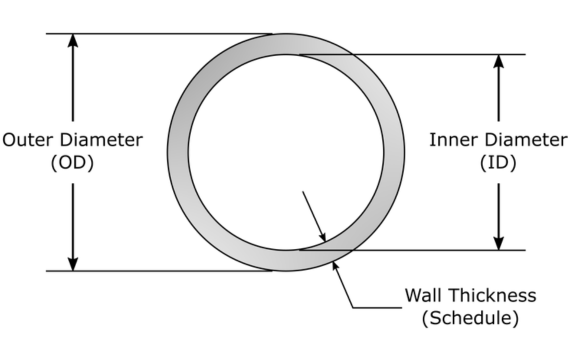You often hear terms like OD, ID, and nominal pipe size. These are different ways to measure & describe pipe sizes. Understanding these terms will help you pick the right pipe for your job.
In this article, we will explain the differences between OD, ID and nominal pipe size. Let’s get started!
Let’s First Understand OD, ID & NPS
You can measure pipes in many different ways. It will help you know their size & how much fluid they can carry. These pipe measurements are called OD, ID & NPS.
- OD (Outer Diameter): This is the measurement from one external edge of the pipe to the opposite external edge. Think of it like measuring the total width of your pipe from the outside.
- ID (Inside Diameter): This type of diameter means the distance from one internal extreme of the pipe to the other internal extreme. It’s equivalent to measuring the internal width of the hole inside the pipe. This is important because it shows how much space is inside the pipe for things like water or gas to flow through.
- NPS (Nominal Pipe Size): It happens sometimes but many people start mixing NPS with other phrases like “national pipe size.” But it’s not the same. NPS is a number that tells us the “size” of the pipe in a general way. It’s used for pipes made of materials like steel, iron, and PVC.

OD vs ID vs Nominal Pipe Size Dimensions
External Diameter: If you measure the outside of a 1-inch pipe, you might find it’s actually 1.315 inches across. The reason behind this is simple. The measurement itself in question also includes the thickness of the pipe walls.
Internal Diameter: If we talk about ID, it is always smaller than the corresponding OD. It occurs because of the walls of the pipe. For example, a 1-inch Schedule 40 pipe has an outside diameter (OD) of 1.315 inches. But, its inside diameter (ID) will be 1.049 inches.
Nominal Pipe Size: This pipe size is a standard way of pipe measurements in almost all regions of North America. It uses a number to describe the pipe size. But, it’s not actually measuring the width of your pipe. Let’s say a 2-inch NPS value. But surprisingly, it has an external diameter value of 2.375 inches.
Pipe Wall Thickness
Pipes too have multiple variable wall thicknesses. We call them schedules. The most common is Schedule 40. There are thicker ones too such as Schedule 80 for extra strength.
The thicker the wall, the stronger the pipe will be. Let’s assume a scenario. There is a 1-inch pipe having Schedule 40. However, the same pipe has a 0.133 value of its wall thickness. As a result, a Schedule 80 pipe has a wall thickness of 0.179 inches. You can see the difference.
Below is a simple table to understand the different measurements better:
| NPS | OD | Schedule 40 Thickness | Schedule 80 Thickness |
| 1/2″ | 0.840″ | 0.109″ | 0.147″ |
| 3/4″ | 1.050″ | 0.113″ | 0.154″ |
| 1″ | 1.315″ | 0.133″ | 0.179″ |
| 1-1/2″ | 1.900″ | 0.145″ | 0.200″ |
| 2″ | 2.375″ | 0.154″ | 0.218″ |
The above table shows how the OD stays the same for a given NPS. However, the wall thickness changes. As the wall gets thicker, the ID automatically gets smaller.
FAQs
Is PVC Pipe Sold By ID or OD?
PVC pipes are usually identified by its ID (Internal Diameter) and not OD. But, many beginners make this mistake. They use the term OD when ordering parts.
What Is The OD of 1 Inch Pipe?
The external diameter of a 1-inch pipe is 1.315 inches. This measurement includes the thickness of the pipe walls. That’s why the outside is slightly larger than the nominal size (NPS).
What Actually Is Nominal Pipe Size? Is It ID or OD?
If we talk about the nominal pipe size (NPS), it basically depends 100% on the internal diameter (ID) value of the given pipe. What does it mean? Well, it means a 1.5 inches pipe has an inner diameter value almost equal to one & a half inches.
Final Words
So, if you understand OD, ID & NPS well, it will help you choose the right pipes according to your requirements. OD measures the outside width, ID measures the inside width & NPS is an American standard size name based on the inside diameter.




